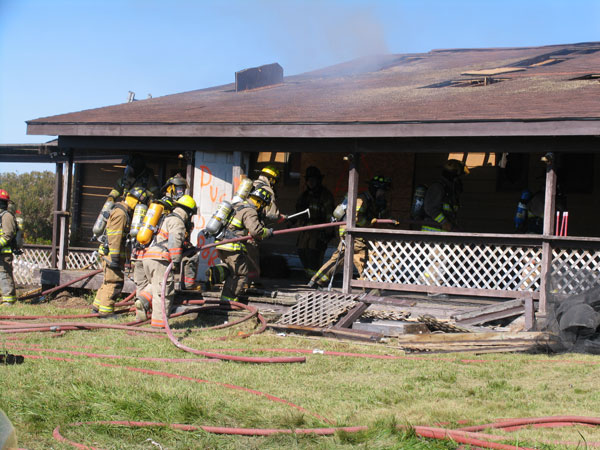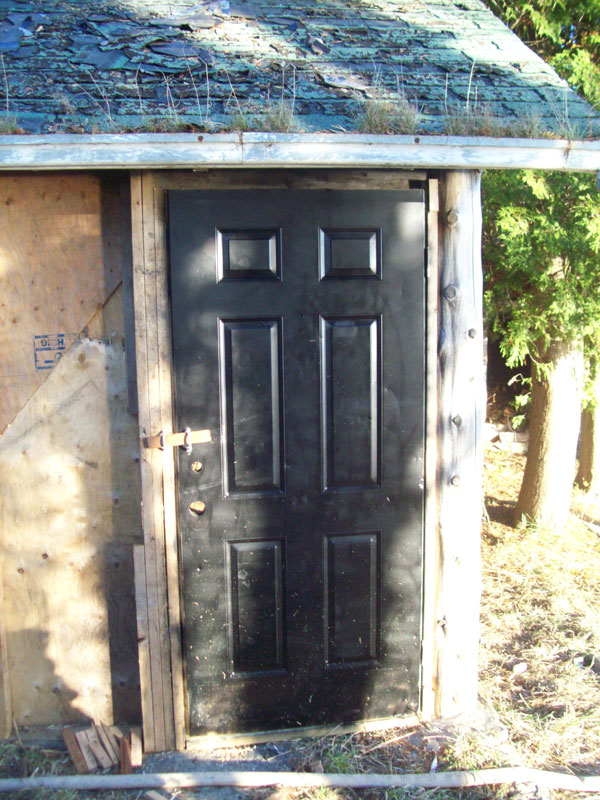
By Mark van der Feyst
In my previous article, we discussed all the important factors to consider when setting up any live-fire training exercise. Whether it is conducted in an acquired structure or a fixed facility, there are a number of items to be completed before the first set can be lit. So why do we conduct live-fire training exercises? What are we training to do? This is a good question to ask whenever setting up any live-fire training, or any training for that matter. Setting out specific objectives will only aid in making the exercise successful.
Let’s first consider some things that we do not want to practice at any live-fire training exercise. When using an acquired structure or a fixed facility, we do not want to be training on pump operations. An experienced pump operator needs to be assigned to each of the apparatus that is being used for your primary and secondary water supply. This will ensure no interruption in your water flow and will maintain an adequate amount of pressure in the handlines. Using the live-fire training exercise as an opportunity to practice pumping skills for inexperienced firefighters will only lead to the beginnings of failure for the entire drill. This is especially true with acquired structures, where fire conditions can change quickly and need to be controlled with proper amounts of water at adequate pressures. This is not as critical in a fixed facility, since there is a high safety factor built into the structural integrity of the building; the only combustible items will be the burn set for class-A fires. Practicing operating a pump during a “roll-in” drill would be sufficient as long the secondary source of water is established and ready.
A major component to train on is the rescue of civilian fire victims from inside the structure. The use of training manikins lets us simulate the experience of rescuing a real victim. We do not want to train on rescuing people from fire using live victims. National Fire Protection Association Standard 1403, Standard on Live Fire Training Evolutions, clearly states that this is forbidden. Any time live fire is introduced into the scenario, live victims are not allowed. This is because of past events that have used live victims with disastrous results. A recent training event where live victims were used was in New York in September 2001. Here two live victims were placed inside a structure to portray lost firefighters needing to be rescued. To make the scenario more real, the instructor set a foam mattress on fire, which quickly escalated as fire traveled up the stairs. One firefighter died and two others were seriously injured (a report on this incident can be viewed at http://www.cdc.gov/niosh/fire/reports/face200138.html. We do not want to train on rescuing live victims from any fire environment.
A mild form of using live victims during live-fire evolutions is calling or practicing Mayday drills. I have witnessed this occur during live-fire training evolutions: an instructor will call a Mayday or will have a student call one so that the rapid intervention team is deployed to come and rescue them, or they are rescued by inside crew members and carried out. Live-fire training is not the place to practice Maydays, especially in an acquired structure. The firefighter that is calling the pretend Mayday can be injured or have their face piece pulled off or moved from proper position during the rescue, exposing the firefighter to the atmosphere within the burn environment. Practicing Maydays can be done during nonlive-fire training events that are directed to Mayday practice specifically in a safer environment. The term Mayday should be reserved for actual emergencies so that when it is called, it will be responded to appropriately without confusion.
We also do not want to train on flashover recognition or conditions. Flashover training is valuable, but only in a properly built container designed for this type of training. Using an acquired structure or even a fixed facility for this will produce fatal results. If you search the Internet, you will find videos from fire departments and firefighters producing flashovers within acquired structures. This is being done on purpose to supposedly train other firefighters on the realities of flashover. If you are following NFPA 1403 correctly in an acquired structure or fixed facility, there is to be no flammable or combustible material inside such as furnishings, floor coverings, or certain wall coverings. Without these items present, the chance of flashover is greatly reduced. Flashover can still occur if fire conditions are allowed to have their way and not be controlled or extinguished, but to purposefully create flashover conditions will certainly produce fatal results.
Listed above are only four items that we do not want to train on when conducting live-fire training. There are more items that we could discuss, but these four are the most common that occur on a frequent basis. So now let us consider what items we do want to train on. Usually we want to incorporate our basics of firefighting into our evolutions: forcible entry, ventilation, search and rescue, laddering, hose advancement, fire attack, and overhaul. The opportunity to practice incident command can also be done provided there is an instructor with the student/firefighter who is in command.


Forcible Entry
Forcible entry isn’t practiced enough, and the opportunity to actually use your skills is rare for some. At live-burn training, forcible entry can be incorporated into the scenarios. Building a door prop is very easy to do for both a fixed facility and acquired structure. Pictured in the photos above is a door prop that was built for an acquired structure. This door was taken from the inside of the structure and was placed into a makeshift door frame using the front porch support posts. Notice that the door is not blocking any primary means of access or egress. It was designed to be away from the front door. The idea here is to make the initial inside truck crew force open the “front door.” Until the door is forced open, no attack crews can go in. This has to be timed with the ignition officers on the inside. The use of smoke machines helps to add the realistic effect of smoke coming from the structure. Once the door has been forced open, the inside truck crew can then enter and conduct their primary search.
Ventilation
There are a number of ways to practice ventilation. The easiest way is to practice hydraulic ventilation once the fire has been knocked down. Ensuring proper instruction on how to conduct hydraulic ventilation will be essential. To train firefighters on how to cut ventilation holes, you must go to the roof. On a fixed facility this may not be feasible, but if it is, it can be accomplished by placing wooden skids on top of the roof. This exercise will go hand in hand with laddering skills. One assigned task will consist of laddering the building to get to the roof, bringing up the required tools, sounding the roof and then cutting a vent hole. By using wooden skids on the roof of a fixed facility, you will still be able to practice cutting through a wooden material with an ax or chain saw. On an acquired structure, this can also be accomplished by going on the actual roof. Pay careful attention to ensure that the roof is able to support the weight of the assigned crew. If conditions are deteriorating the roof, then this task will have to be carried out in a different fashion. Some acquired structures will have enough roof space to allow a team to cut a series of vent holes without being over top of the fire. The practice here is realistic in that firefighters are cutting through actual roofing materials to make a decent-size vent hole. Using wooden skids as described will also work if you’re at a fixed facility.
Search and Rescue
As mentioned earlier, use manikins to portray victims inside the structure. Searching for victims will be assigned for every evolution or scenario. It is a major benchmark that we must ensure we reach by declaring an “all clear” for both primary and secondary searches. The one thing that I have witnessed instructors do is to place victims in areas that firefighters will never find. We are not going to find victims that are hidden in fridges, on top shelves of closets or cupboards, or stuffed in holes in the wall. Victims are generally going to be found in one of four places: by windows, by doors, at the fire location, or in their beds. Place our “victims” in these type of locations so that you give your firefighters the opportunity to exercise their search skills. We can also place manikins in the windows hanging halfway out to simulate rescuing victims from buildings. This will reinforce the need to do a complete walk-around and also gives practice using ladders to conduct a rescue from the outside rather than from the inside. Training on special tactics such as vent-enter-search (VES) is also a good way to reinforce the skills needed to rescue people. This will require you to build a window prop that will allow the firefighter to “break” glass and then enter the room. Knowledge on how to conduct VES is also essential as there are many firefighters out there who are not clear on how to perform this operation.
Laddering
We have mentioned laddering already in our previous sections. Laddering can be incorporated into every assigned task. We can have the hoseline advanced up a ladder, victims brought down a ladder, and ladders put up for firefighter-survival reasons. Either way, a ladder can be raised by one or two people, and a good place to practice this is outside on the fireground.
Hose Advancement
Live-fire training is a great place to practice hose advancement. Depending upon the scenario, the attack crew and the backup line crew will be advancing hose up stairs, down stairs, around corners, or even up ladders. This is also a good place to practice advancing hose with two-man or three-man teams, since many departments operate with this level of staffing.
Fire Attack
This is the main reason why we conduct live-fire training. The opportunity to suppress a fire is not always available to all firefighters, so we must practice this by training. Using class-A materials or propane-fed towers will help in accomplishing this goal. Usually, live-fire training involves conducting an offensive attack, but we rarely practice setting up a defensive attack then going offensive. The training ground is the perfect place to practice these different types of scenarios. Here we can build in a margin of safety while conditions are under our control and practice different tactics.
Overhaul
In acquired structures, overhaul must be trained on at the conclusion of every evolution. Once the fire has been knocked down, overhaul must take place, else fire may extend up through the roof and the whole structure will be lost. In a fixed facility, this can only be practiced by overhauling the burn pile. It’s not very effective, but it’s practice none the less.
The benefits of conducting live-fire training are plenty and are valuable to improving and developing the skills of the everyday firefighter. Knowing exactly what you want to train on is the key to the success or failure of this type of training evolution.
MARK VAN DER FEYST is a 14-year veteran of the fire service and a member of the Woodstock (Ontario, Canada) Fire Department. He is an international instructor teaching in Canada, the United States, and India; a local level suppression instructor for the Pennsylvania State Fire Academy; and an instructor for the Justice Institute of British Columbia.

